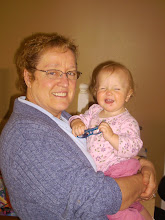My mother died of heart disease in 1981, when my youngest daughter was 14 months old and my youngest son wasn't yet thought of. What my older children remember, besides that she made yummy lemon pies, is that she was always sick and they had to be quiet.What they don't remember about her is that she was determined, tough, and very kind-hearted. If I were to name another defining characteristic, it would be her stoicism. Once I called to ask how she was feeling so that maybe we might visit. (Not that her answer could ever form a basis for this decision since it never contained the needed information.) She told me she was fine and we should come. When we arrived, I found her really suffering from shingles. My dad was fixing dinner. Two weeks before she died she wrote a letter to the family for a time capsule. She must have asked three times for us to excuse her poor hand-writing because she wasn't feeling very well. Yuh!
My mother' genealogical lines in Iceland go back more than a 1000 years. (Those people knew how to keep records.) I once heard an interview with an author who grew up in Gimli, Manitoba. In case you didn't know, Gimli, on the western shore of Lake Winnipeg, was settled by more than 1500 Icelandic immigrants between October 1875 and the summer of 1876. The author had done some research around the suffering of these people in 1876 from smallpox, cold and deprivation. He gave talks about it and not one believed him because their grand-parents had nothing to them about it. So they were certain it didn't happen. He went on to tell a story from an old Icelandic saga. It went something like this:
"There was a terrific bloody battle and a runner was sent to the the Althing (the English version of this word) with news. By the time he arrived, after running over the ice and snow, his shoes were completely gone and his feet were bleeding. As he walked into the hall to report, he left bloody footprints on the stone."
The point of the story was not his great courage in running when his feet were bleeding, it was that as he walked into the hall leaving bloody footprints, he did not flinch. As this author talked about this characteristic of Icelandic people to never complain, I recognized my mother. She was a Viking.
My mother has passed this characteristic onto some of my children and grand-children. One of my grand-children split open his eye-brow and needed stitches. It took four adults to hold him down while he kicked and screamed so the stitching could be done. He was four. It's understandable but it is not Viking. Compare that to this: At the same age, another grand-child, with a cut in approximately the same place, laid on the table, under a sterile sheet without moving or even squeaking while they stitched. I assume she gritted her teeth. She would have been highly embarassed to make a fuss. She is a Viking. Another grand-son got a cut on his chin. Although he hates people in his space, he finally just gritted his teeth (for real) and let them do it. Once my daughter told my son, who was quite sick and miserable at the time, that he should whine more when he was sick. He just stared at her and finally said, "And just exactly how would that help?" She couldn't explain, she only knew it helped her. He knew it wouldn't help him at all.
This cannot be nurture when there are children in the same families who are so different. You cannot easily "teach" a child not to complain or even scream in a crisis! They just come the way they are. You can turn a child a little to the right or a little to the left, but if you think that as a parent you can turn a child completely around, I fear you are in for disappointment. My children also have Welsh, Scots, German, Danish and English blood. The Viking is diluted even more in the next generation. Still there are Vikings among us.
Wednesday, November 25, 2009
Subscribe to:
Post Comments (Atom)

I think my son was both the story of the cut on the chin and the cut on the forehead. The difference is that with the cut on the head, he was younger and really didn't want to be forced to lie down. I think that might be a Viking response, too. The second time, he was old enough to understand the importance of getting stitches.
ReplyDeleteNah, the forehead story was Joel. Your son IS a Viking. I think Carmen is a Viking NOW, even if she wasn't as a child. Don't hear any complaining from her. Maybe that's what you mean. People can grow into it as they become more themselves.
ReplyDeleteI was definitely a child who had to be taught to control my emotions. I remember my mom telling me, "You can cry, just cry quietly." Now I find myself repeating those same words since I have a screamer of my own...
ReplyDeleteSEVENTEEN grandkids, wow! :)